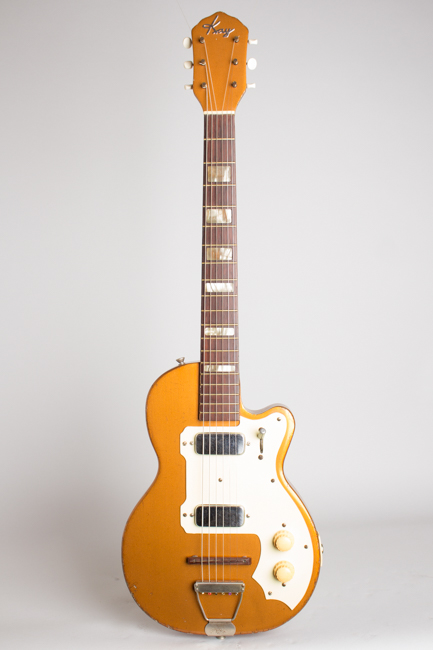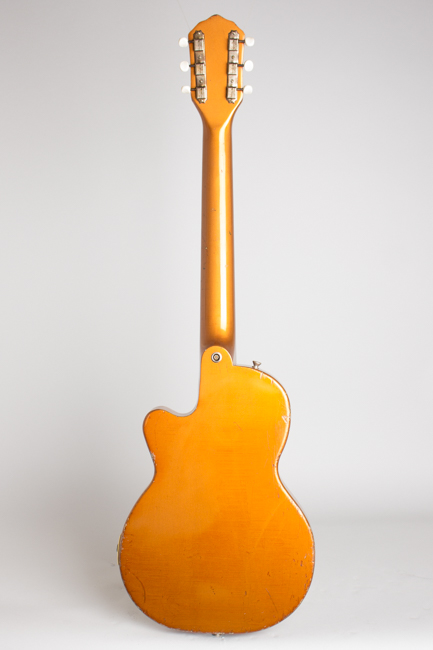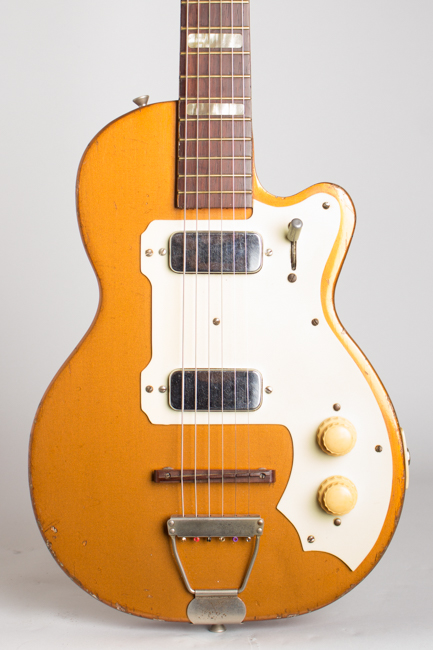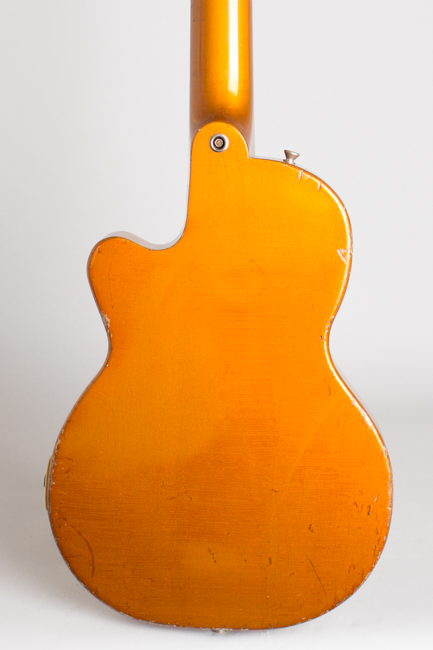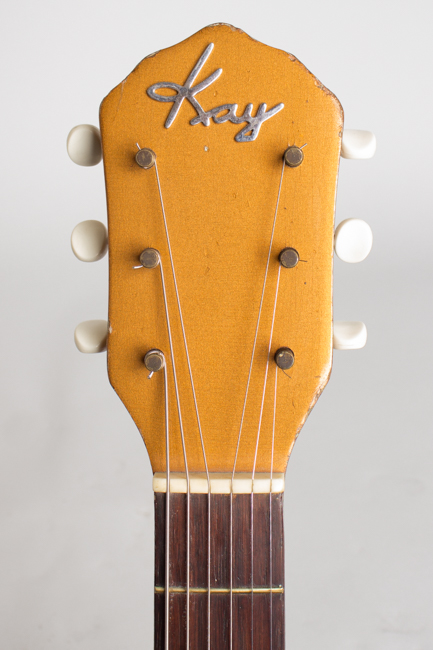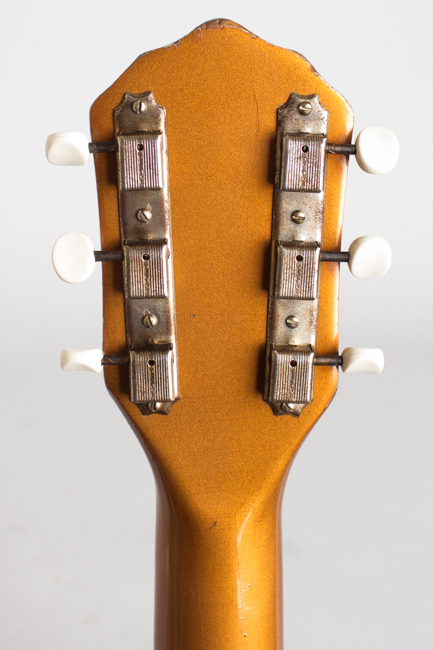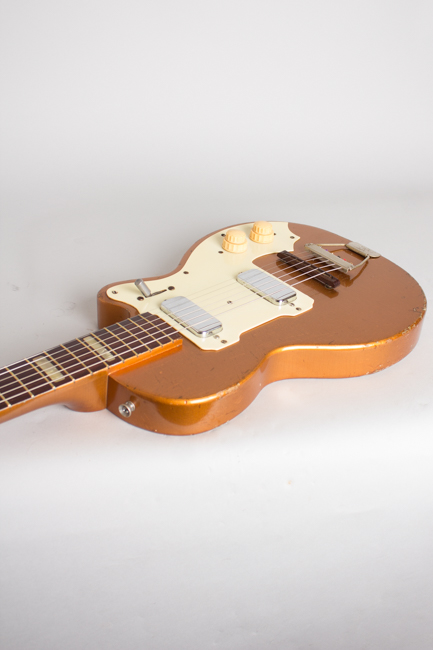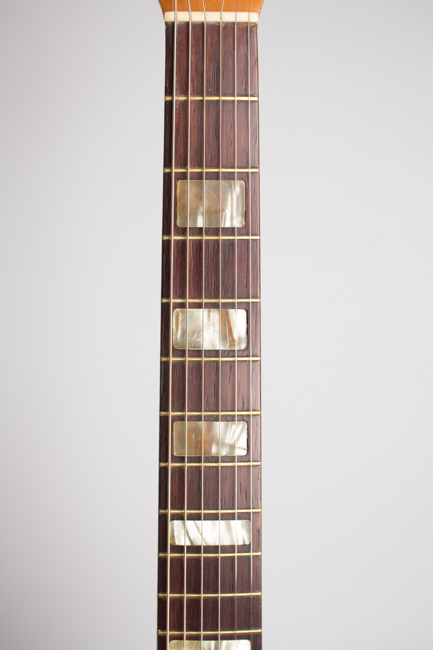Kay K-142 Solid Body Electric Guitar , c. 1956
This item has been sold.
Item # 7196
Prices subject to change without notice.
Kay K-142 Model Solid Body Electric Guitar, c. 1956, made in Chicago, bronze lacquer finish, hardwood body and neck, rosewood fingerboard, black hard shell case.
When Fender's revolutionary Broadcaster guitar was introduced in 1950, most established guitar builders scoffed at the "plank" solidbody concept. When the Gibson Les Paul appeared in 1952, the rest of the industry all sat up and took notice, and soon nearly everyone had some sort of solidbody in production. This K-142 was part of Kay's response to the Les Paul, the company's first solid step into the new market. This is the deluxe double pickup version, a fairly rare guitar and seemingly little remembered despite being a "solid" entry into the field. Kay also offered the K-172 "Pro" model, but like similar guitars from Gretsch and Guild, this had a small semi-hollow body, not a solid one.
Jumping into the early '50's solidbody pond Chicago competitors Kay and Harmony hit on generally very similar designs, with small single cutaway bodies and integral necks. Harmony's Stratotone is better remembered (the power of a catchy name?) but the K-142 is at least its equal as a guitar. The most notable feature is the neck-it is VERY thick with a beefy round profile and pearloid block inlaid rosewood fingerboard. The body is flat topped with less rounded edges than the Harmony giving it a chunkier feel. The entire guitar is finished in a metallic copper lacquer, topped off with a cream plastic pickguard.
There are two single-coli pickups under chrome covers, controlled by a large lever switch and a set of twin concentric tone and volume pots. The one-piece rosewood bridge is adjustable for height (an advantage the Stratotone does not offer) and mated to a standard short trapeze tailpiece. The K-142 listed at $125 in 1956-about half the price of a Les Paul- and was described as "An exciting two-pickup Spanish electric that offers fine professional quality at a moderate cost'. In the same catalog Kay has the cojones to describe the neck as "The slim, balanced tension Speed Demon Neck stands for supreme playing ease". While "slim" is a highly optimistic description there is a sort of adjustable truss rod installed, operated from the rear of the heel with a banjo key. All in all this is a really cool early solidbody with a great sound and a cool period vibe.
Overall length is 37 1/4 in. (94.6 cm.), 12 in. (30.5 cm.) wide at lower bout, and 1 3/4 in. (4.4 cm.) in depth, measured at side of rim. Scale length is 25 3/4 in. (654 mm.). Width of nut is 1 3/4 in. (44 mm.). This guitar is in well-preserved condition with all original finish and hardware except for newer buttons on the original Kluson deluxe tuners. There are dings to the finish all around the body edges while the top, back and neck have some checking but no major finish loss. The neck is straighter than many of these and the frets have been leveled, so playability is better than most. No, this does not play like a '50's Les Paul, but as these early Chicago-made early solidbodies go this is a relatively usable example. The pickups are quite strong and this is a fairly raunchy sounding guitar, very appropriate for period electric blues and early rock sounds. Includes a more recent HSC. Overall Excellent - Condition.
When Fender's revolutionary Broadcaster guitar was introduced in 1950, most established guitar builders scoffed at the "plank" solidbody concept. When the Gibson Les Paul appeared in 1952, the rest of the industry all sat up and took notice, and soon nearly everyone had some sort of solidbody in production. This K-142 was part of Kay's response to the Les Paul, the company's first solid step into the new market. This is the deluxe double pickup version, a fairly rare guitar and seemingly little remembered despite being a "solid" entry into the field. Kay also offered the K-172 "Pro" model, but like similar guitars from Gretsch and Guild, this had a small semi-hollow body, not a solid one.
Jumping into the early '50's solidbody pond Chicago competitors Kay and Harmony hit on generally very similar designs, with small single cutaway bodies and integral necks. Harmony's Stratotone is better remembered (the power of a catchy name?) but the K-142 is at least its equal as a guitar. The most notable feature is the neck-it is VERY thick with a beefy round profile and pearloid block inlaid rosewood fingerboard. The body is flat topped with less rounded edges than the Harmony giving it a chunkier feel. The entire guitar is finished in a metallic copper lacquer, topped off with a cream plastic pickguard.
There are two single-coli pickups under chrome covers, controlled by a large lever switch and a set of twin concentric tone and volume pots. The one-piece rosewood bridge is adjustable for height (an advantage the Stratotone does not offer) and mated to a standard short trapeze tailpiece. The K-142 listed at $125 in 1956-about half the price of a Les Paul- and was described as "An exciting two-pickup Spanish electric that offers fine professional quality at a moderate cost'. In the same catalog Kay has the cojones to describe the neck as "The slim, balanced tension Speed Demon Neck stands for supreme playing ease". While "slim" is a highly optimistic description there is a sort of adjustable truss rod installed, operated from the rear of the heel with a banjo key. All in all this is a really cool early solidbody with a great sound and a cool period vibe.
Overall length is 37 1/4 in. (94.6 cm.), 12 in. (30.5 cm.) wide at lower bout, and 1 3/4 in. (4.4 cm.) in depth, measured at side of rim. Scale length is 25 3/4 in. (654 mm.). Width of nut is 1 3/4 in. (44 mm.). This guitar is in well-preserved condition with all original finish and hardware except for newer buttons on the original Kluson deluxe tuners. There are dings to the finish all around the body edges while the top, back and neck have some checking but no major finish loss. The neck is straighter than many of these and the frets have been leveled, so playability is better than most. No, this does not play like a '50's Les Paul, but as these early Chicago-made early solidbodies go this is a relatively usable example. The pickups are quite strong and this is a fairly raunchy sounding guitar, very appropriate for period electric blues and early rock sounds. Includes a more recent HSC. Overall Excellent - Condition.
